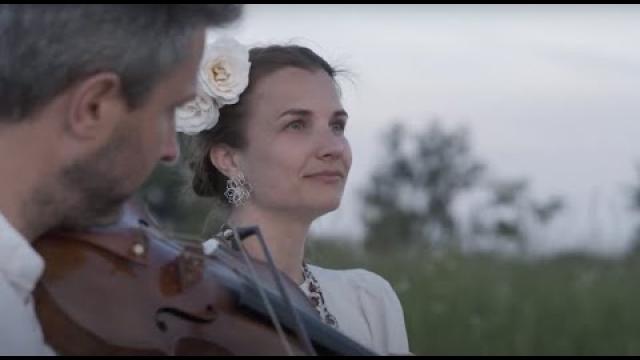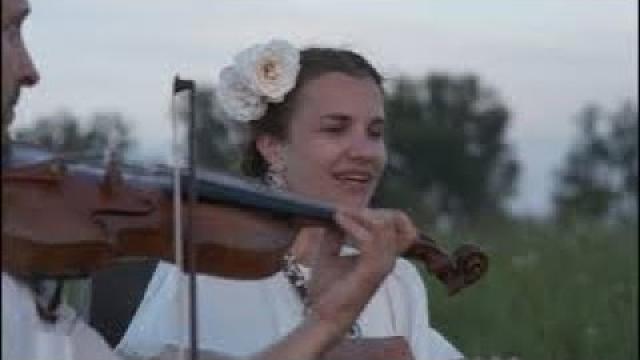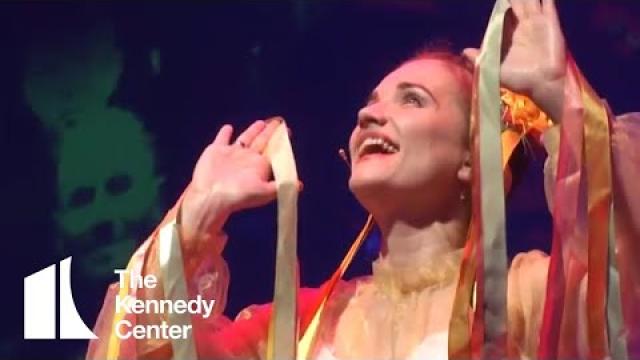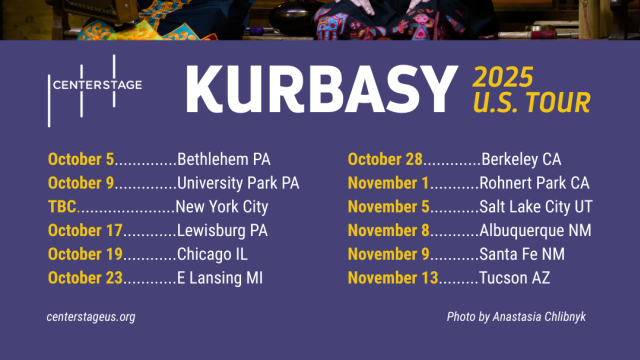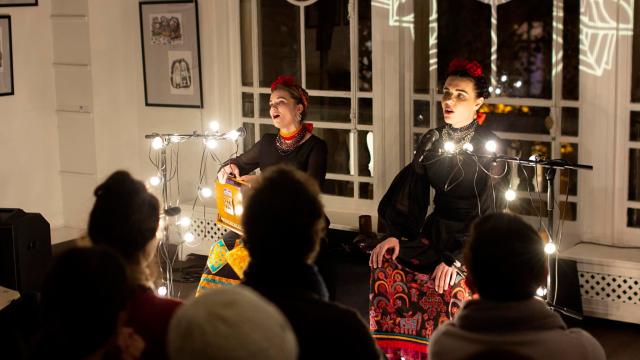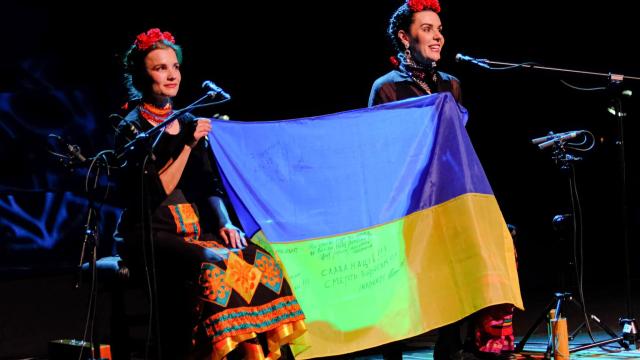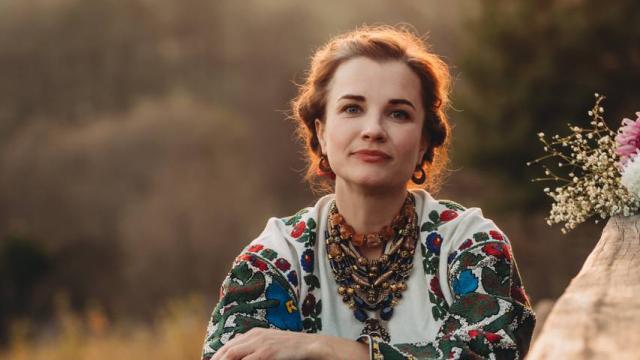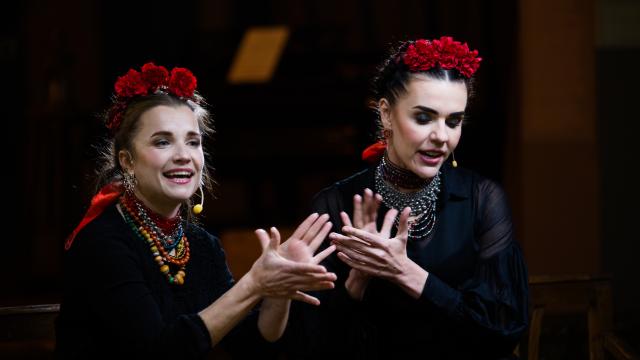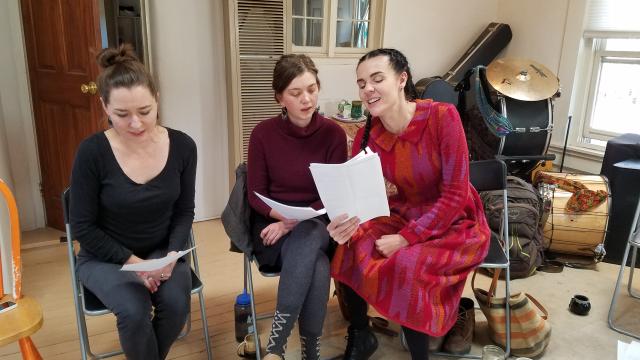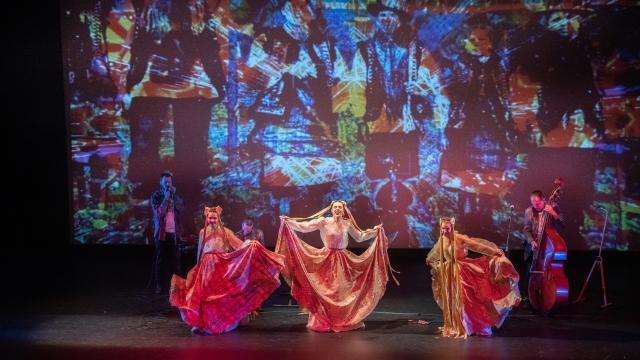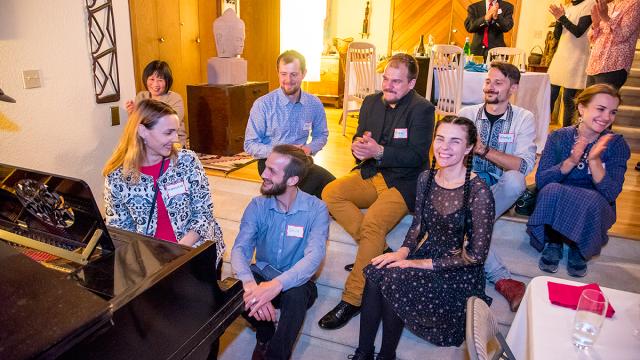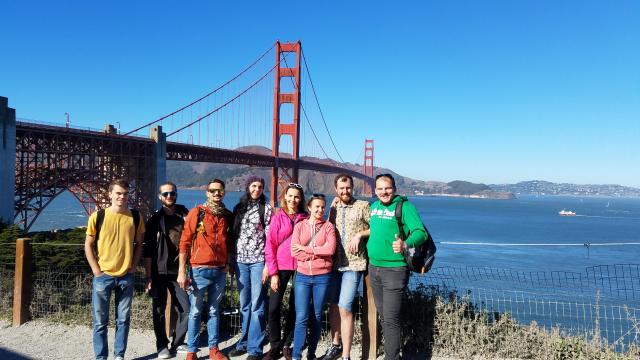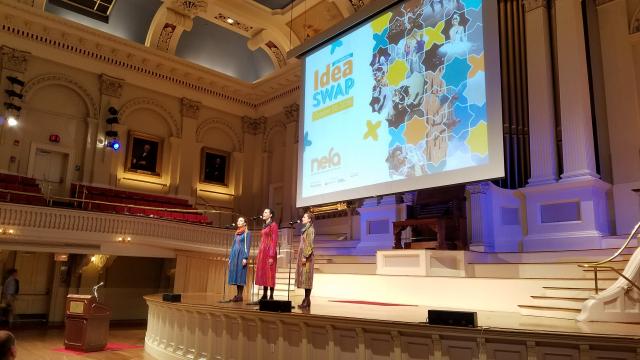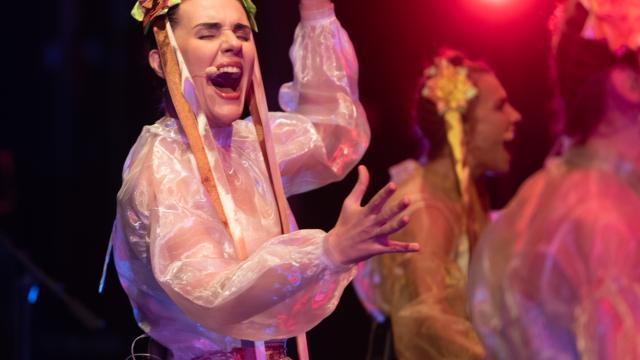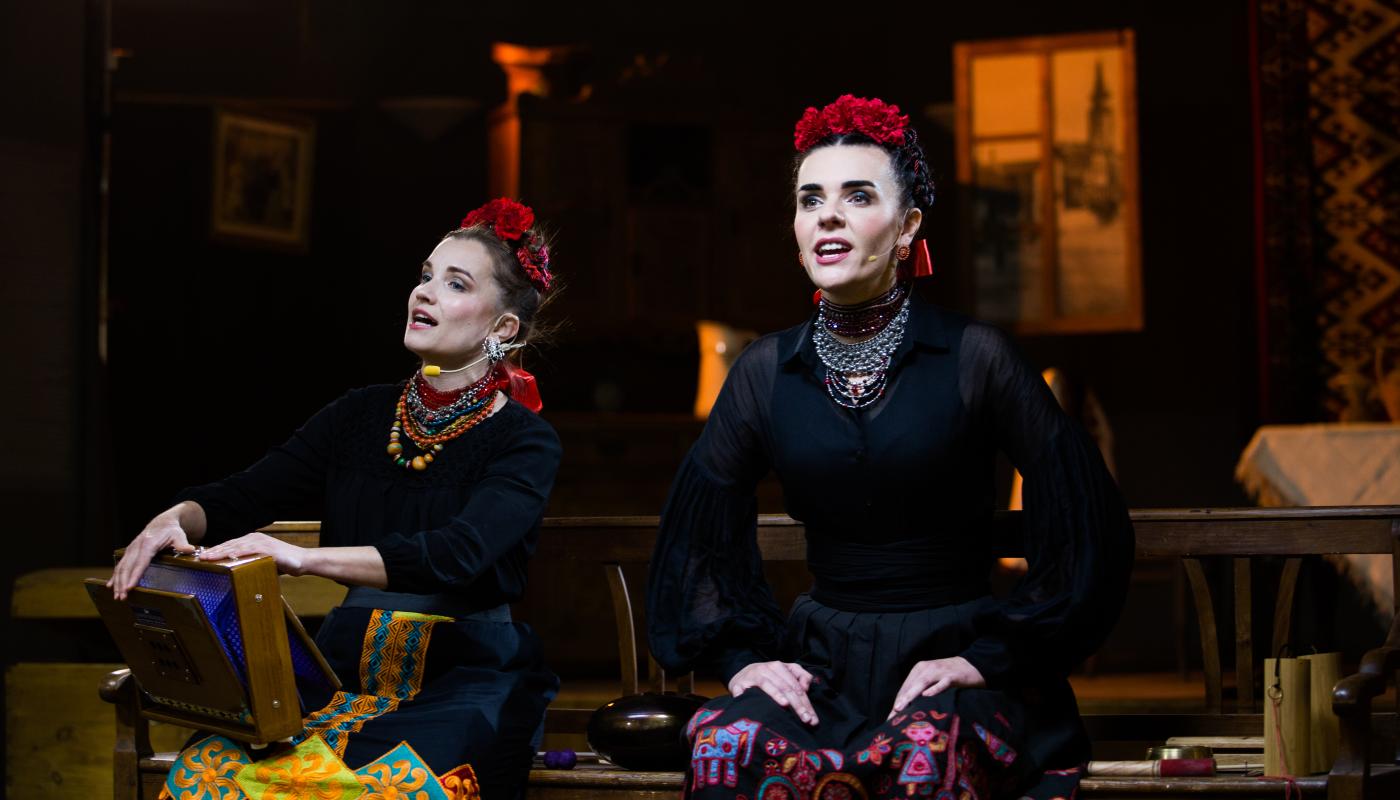
Kurbasy

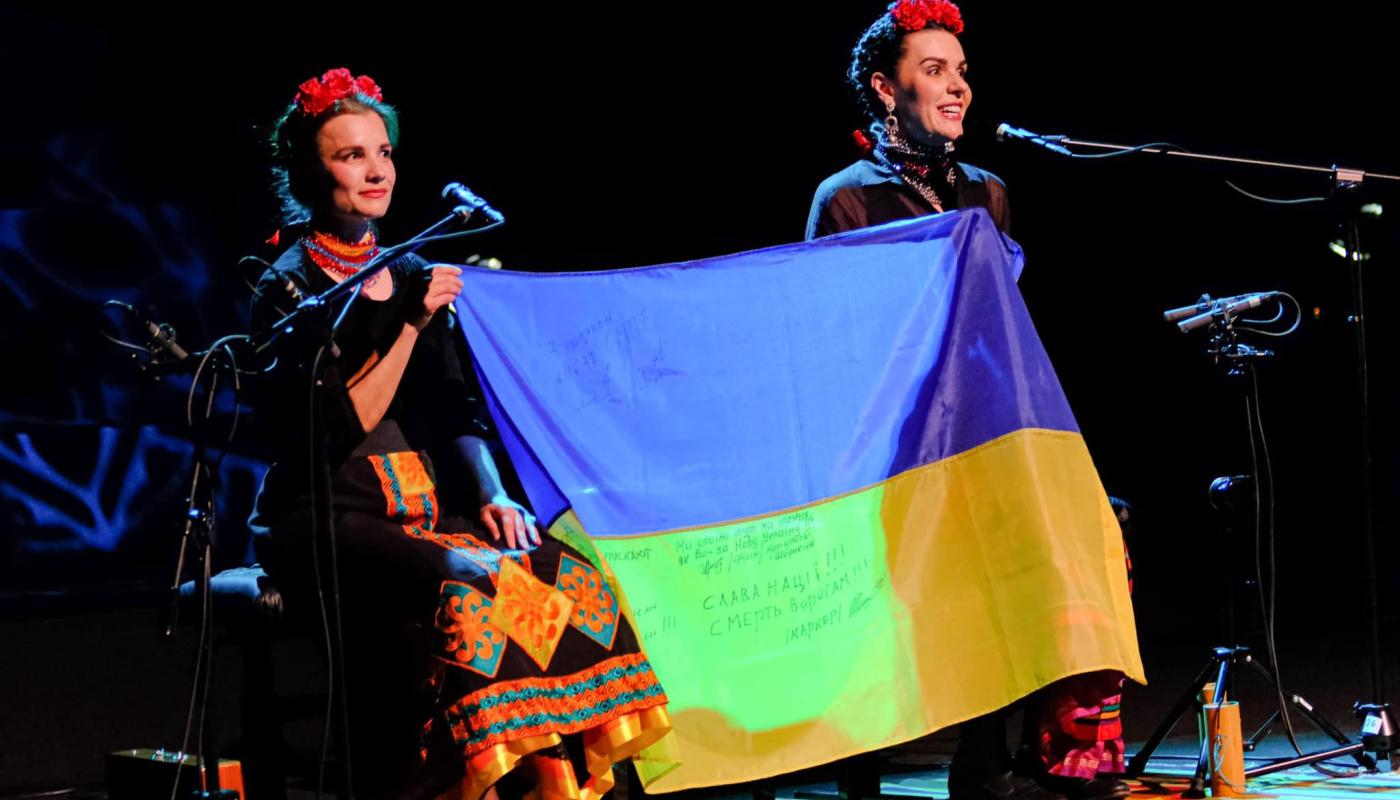
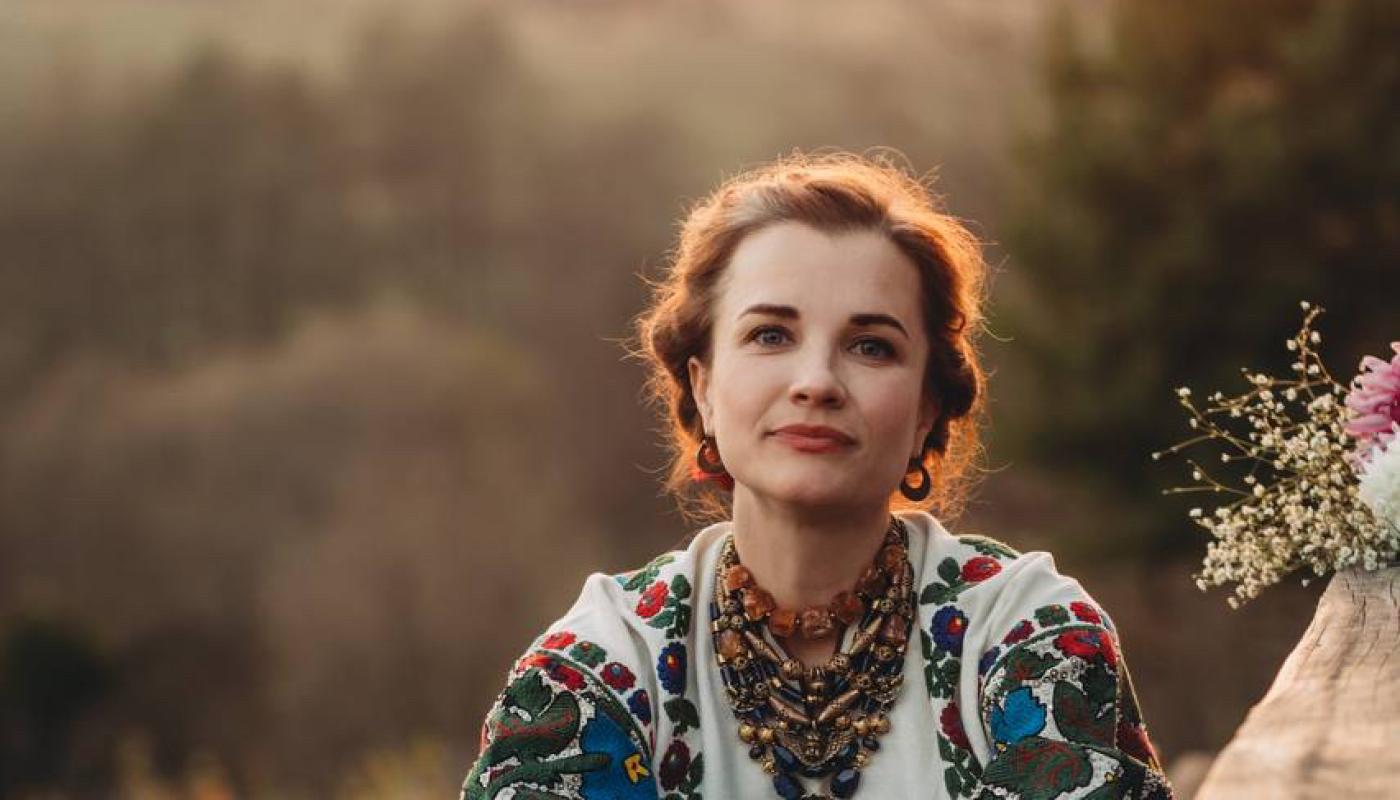
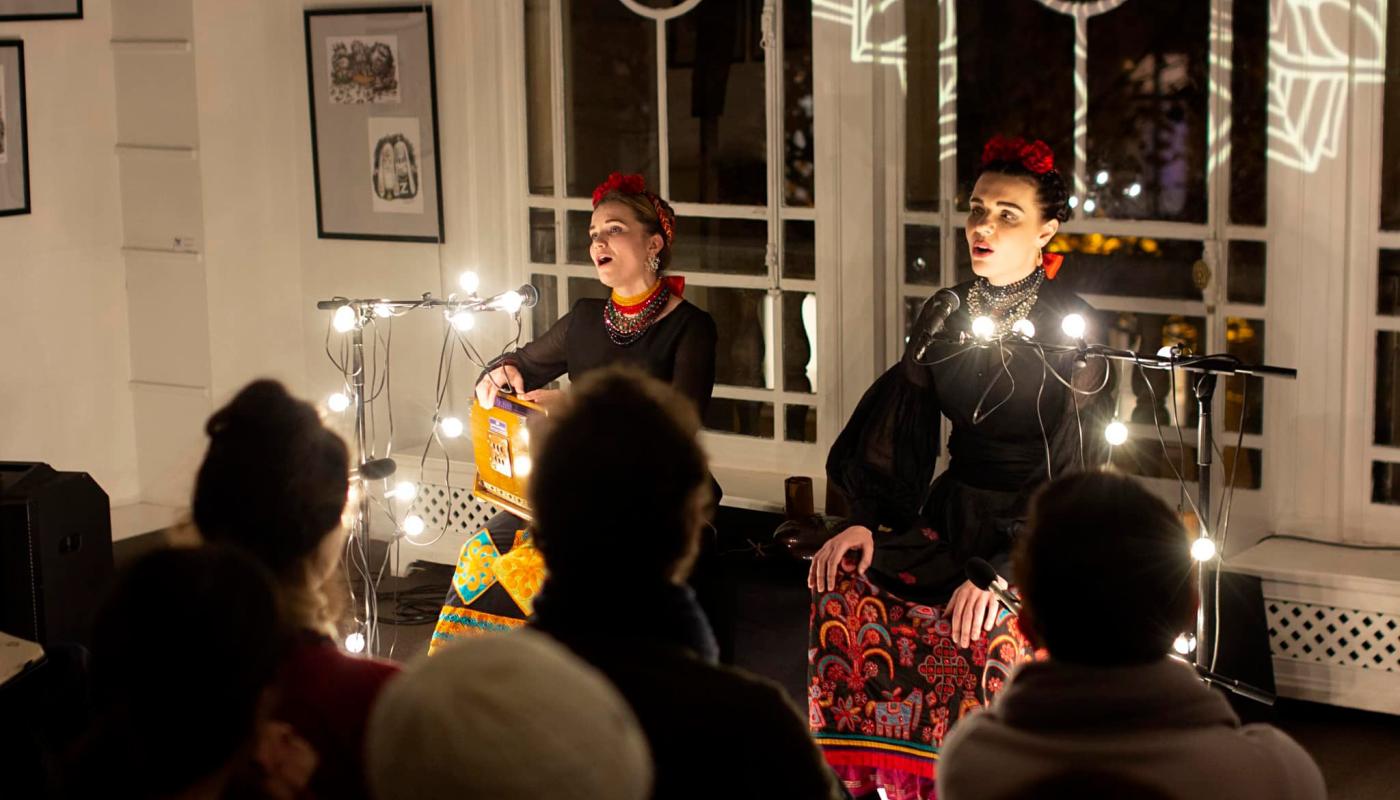
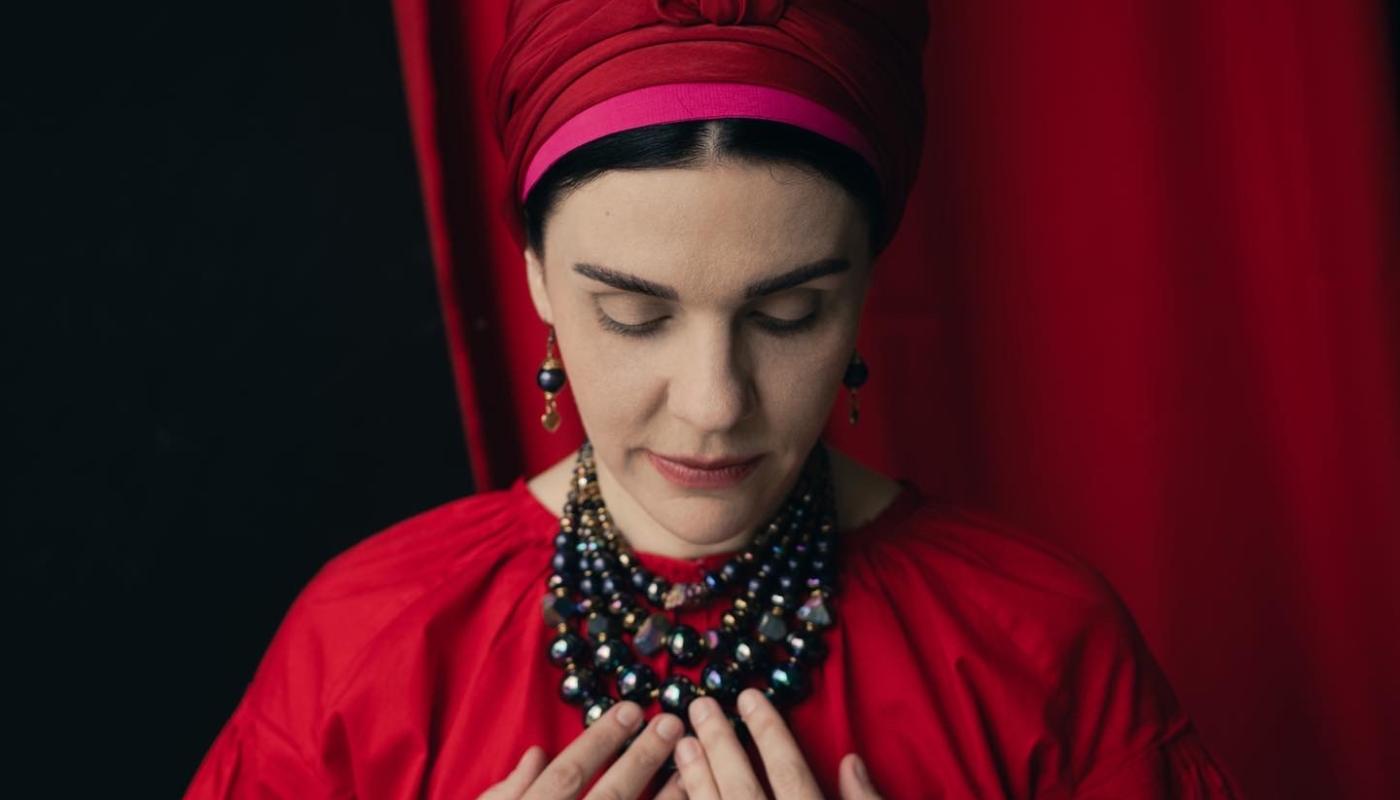
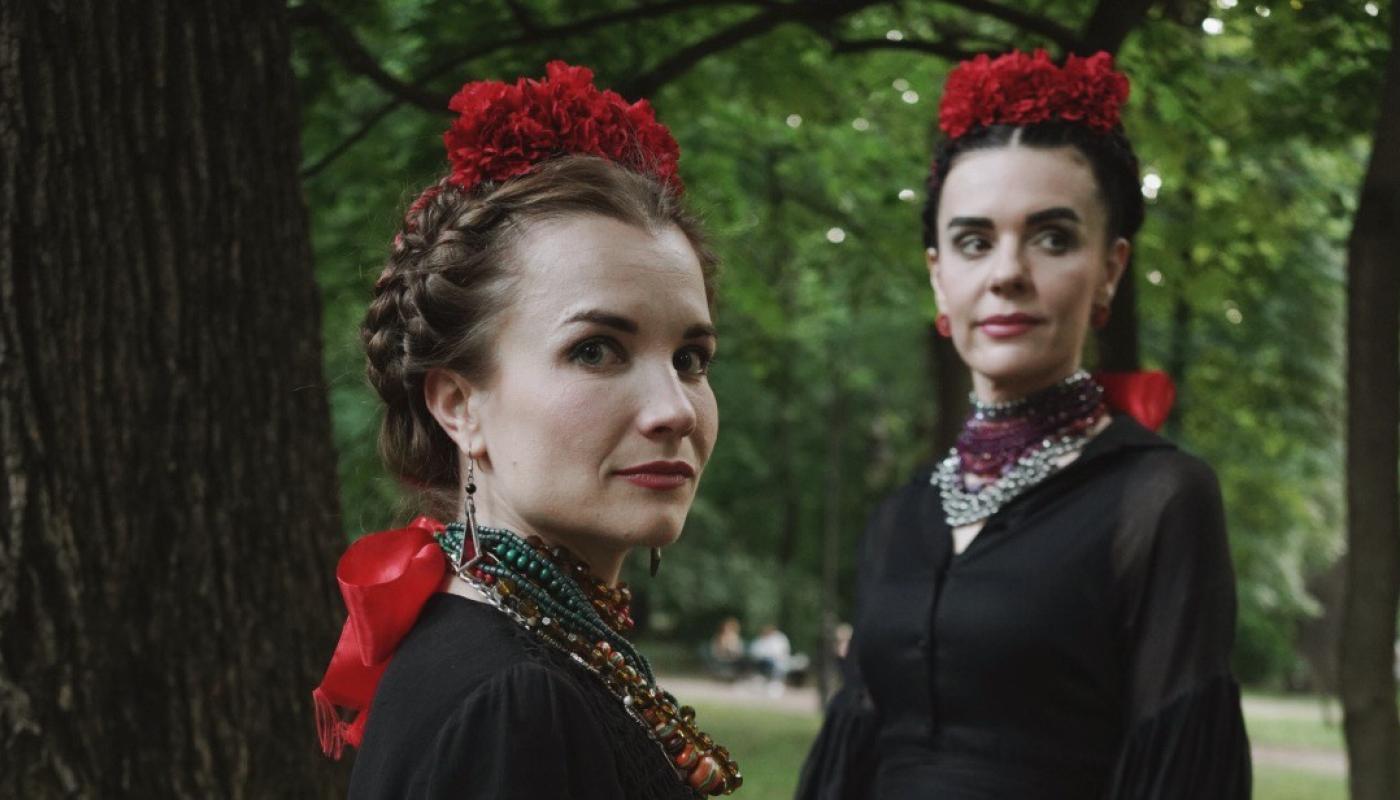
Affirmation in a time of violence and resistance: Kurbasy channels contemporary connections to an archaic past with its time bending Songs of the Ukrainian Forest
Events
Events
The idea of culture as a cosmic living organism is central to Kurbasy’s, whose folk-based multimedia performances vibrate in tight vocal harmonies, resonant lyrics, distinctive instrumentation, and phantasmagoric visual imagery. Kurbasy’s sonic-theatrical explorations of Ukraine’s rich trove of calendar songs, lullabies, and legends, conjure the natural world, beliefs, and rituals, channeling contemporary connections to an archaic past.
Songs of the Ukrainian Forest, was conceived by Kurbasy’s founders and friends of 24 years, actor-vocalists Natalia Rybka-Parkhomenko and Maria Oneschak, in a time of pandemic lockdown and then national invasion. The duo is performing the work at home and abroad as a polyphonic vocal piece while building the larger instrumental frame that will surround it on tour to the U.S. in 2025. The production will also feature full-stage projections by designer Gryca Erde, https://grycja.art
The 14-song cycle draws on the repertoires of the Eastern, Central and Western Regions of Ukraine. The language varies according to the origin of the songs, for example those of the border regions with Poland are in Lemsky dialect, a mixture of Ukrainian and Polish. The lyrics tell stories of boys and girls, stories of love, joy, but also of war. “We want to affirm our loud and clear freedom, our love for our country and for our people,” said Maria. “We want to show our independence and strength,” Natalia adds.
Videos
Songs of the ukrainian forest
Public performances: 60 minutes without intermission
Student performances (recommended for grades 6 and older): 40 minutes + Q&A
travelers
9 on tour: 6 musicians, sound and video engineers, Center Stage company manager
venues
Concert halls, theaters and other spaces with excellent acoustics and capacity for large scale video projection
Spring is summoned, the summer season is celebrated, wedding ceremonies are sung, and life stories told. Kurbasy envelops us in magical-musical charm.
lokalkompass.de
About kurbasy
Kurbasy is an avant-garde musical project of the renowned progressive Les Kurbas Theatre in Lviv, Ukraine. Founded in 2008 as an informal vocal gathering of singer-actresses, the group has performed across Europe – from the front lines of occupied Eastern Ukraine to concert halls in Western Europe and USA. The ambient approach of Kurbasy gives life to the indigenous polyphonic sounds of Ukraine’s rich traditional music heritage. Led by vocalists, Kurbasy is now experimenting with the sounds of Ukrainian instruments – traditional dulcimer, winds and percussions together with Tibetan singing bowls, violin and double bass.
Their performances trace a theatrical arc to reveal the stories held in each of the songs of their rich repertoire, a collection of which can be heard on ‘Raytse’ a title that references both paradise and the mythical egg at the origins of the universe, released in 2009. Songs from the calendar cycle, Kupala [St. John’s Day/Midsummers] and wedding ritual singing found the core of their second album - ‘Miracle of creation’ 2018. Many of Winter cycle songs from Kurbasy’s newest release ‘Rozkolyada’ 2021, aside from describing biblical and archaic Carpathians Christmas tales are also rich in early slavonic mythopoetic symbols and animalistic ritual images. The theatrical background of the group is a core component of Kurbasy's aesthetic. The music they perform is tied to, celebrates, and renews the rituals and the lived memories of Ukraine and her people.
Photos
▸Access to downloadable high resolution photos here.
World Culture in Context
A package of virtual educational materials, tailored to students in upper elementary through high school will provide a better understanding of the context in which these artists thrive. Visit www.worldcultureincontext.org
Follow this link to view the full version and more information about World Culture in Context.
2025 u.s. tour program notes
Kurbasy
(Lviv, Ukraine)
Mariia Oneshchak and Nataliia Rybka-Parkhomenko, Artistic Directors
“Songs of the Ukrainian Forest”
Created, Arranged, and Produced by Kurbasy
Projections designed by Grycja Erde & Jardim
Mariia Oneshchak, Vocals
Nataliia Rybka-Parkhomenko, Vocals
Vsevolod Sadovyi, Ukrainian Instruments
Severyn Danyleiko, Cello
Artem Kamenkov, Double Bass
Markiian Turkanyk, Violin
Viktoriia Kyrnytska, Sound Engineer
Oleksandra Bezemska, Lighting and Projections Engineer
A song cycle in 75 minutes, presented without intermission
Kurbasy is part of Center Stage, a public diplomacy initiative of the U.S. Department of State's Bureau of Educational and Cultural Affairs with funding provided by the U.S. Government, administered by the New England Foundation for the Arts in cooperation with the U.S. Regional Arts Organizations. General management is provided by Lisa Booth Management, Inc.
Songs of the Ukrainian Forest is a conversation between two actress-singers, longtime colleagues and friends Natalia Rybka-Parkhomenko and Maria Oneshchak. The program took shape in the spring of 2020 during the global pandemic quarantine in one of the forests of Lviv region in western Ukraine, where the two women and their families took refuge together.
Since Russia’s military invasion of Ukraine in 2022, Mariia and Nataliia have performed versions of the work in Ukraine and in Europe as a duo, self-accompanied with hand percussion, Tibetan cymbals and bells, and a shruti box – a small Indian harmonium. With these performances in the U.S., Kurbasy is realizing the opportunity to fully produce this work visually and musically.
The program begins with Spring Songs -- calls to awaken and renew life after the long winter -- and includes ballads and love songs from Polissia, Bukovina, Poltava, Podillia, and Central Ukraine. Traditional recruit songs are sung, which highlight the war time situation in Ukraine today.
An affirmation in a time of war and resistance Kurbasy’s Songs of the Ukrainian Forest reveals contemporary connections to an archaic past.
Song List
Zamovliannia vesny / Spring Invocation
A spring song «vesnyanka» from Podillia. Traditionally, spring songs were sung only by girls, very loudly, in the open air, urging Nature to awake after Winter, and to welcome longer, warmer days and new life.
Pytalasia nenka dochky / A Mother Asked Her Daughter
Spring song
Rozlylysia Vody na chotyry brody / The Waters Flow into Four Fords
Spring song
Ya ptychka-nevelychka / I Am a Little Birdy
A lyrical chant from the Kyiv region; a secular song for a three-part ensemble or choir, which was popular in Ukraine in the 16th–18th centuries. A song about love, where a small bird and a falcon allegorically depict lovers figuring out their relationship.
A vzhe tomu sim lit bude / It Has Been Seven Years
A ballad from Bukovina about a Ukrainian soldier who has been wandering lost in the forest for 7 years and now talks to his mother, who visits him in the shape of a bird and flies off, for she could no longer wait for her son to return from military service.
Oi, shcho zh to za svit nastav / Oh, What a World it is Now
A ballad with a sad story about how a son drove his mother out of the house, after which many sorrows and troubles had fallen on him and his family.
Chyia to dolyna / Whose Valley Is This
A lyrical song about a love triangle -- a girl in love with a Cossack who has a wife and three children
Kolyskovi / Lullabies
Two Ukrainian lullabies accompanied by Tibetan bells and "4 elements of Koshi" chimes
Bilia richky, bilia brodu / By the River, By the Ford
A Lemki song about a cheating girl.
Oi, vershe, miy vershe / O Highlands, My Highlands
One of the most famous Lemko songs recounts thoughts of a girl who regrets that she left her mother and fell in love with a boy with black eyebrows.
V nediliu rano / Early on Sunday
Lemko song about both sweet and bitter sides of young love and betrayal.
Iz-za hory viter viie / The Wind Blows from the Mountain
A spring song from the Poltava region in central Ukraine - with these songs, in ancient times, girls tried to invoke Spring and awaken nature. But they also have lyrical plots, as in this song, where a woman with two children waits for her husband for a long time.
Oi, lisu, lisu + Oi, perepelychko + Rano-rano / O Forest + O Little Quail + Bright and Early
A medley of three songs begins with a Spring invocation (O Forest) and moves to O Little Quail (another version of I am a Little Birdy, popular in the 18th century). Bright and Early is a relic of pre-Christian cosmology and ritual – “Seeing off the Rusalky” whose timing is now linked to the Christian calendar. The week before Pentecost or “Trinity” — the spirits of departed kin temporarily cross the veil between worlds. Locals still honor them with reverence: setting tables, offering food, singing to appease, and finally escorting them ritually into the deep forest — a symbolic return to the other world. It’s a sacred act of balance: welcoming the dead, then gently sending them back, so the living may thrive undisturbed, and cosmic order restored.
Zberimosia Rode / Let’s Get Together, Kindred
Feast song from Podlachia borderland region about unity and the value of going through even the most difficult moments in life together.
Chevrona Kalyna / Red Guelder Rose
This military recruit song from Podillia region describes the burden of a wife whose husband goes off to war. Not only she, but all young girls, families, and entire villages are crying for their loved ones.
National and Regional Ukraine
Ukraine sits at the heart of Europe, bordered to the southwest by Moldova and Romania, to the west by Slovakia and Poland, to the northwest by Belarus and to the northeast and east by Russia. Ukraine’s diverse geography – from the densely wooded Carpathian Mountains to the Dnipro River basin and seaside of Odessa have informed the many and different rites, practices and traditions that together form Ukrainian culture.

Polissia — Ukraine’s most archaic cultural region. Sheltered by dense forests and vast marshlands, and historically insulated from major geopolitical upheavals, Polissia has preserved archaic songs, rituals and cosmological beliefs dating back to Kyivan Rus’ and even pre-Christian times. Remarkably, recent genetic studies pinpoint this borderland between Ukraine and Belarus as the cradle of the distinct Slavic genotype — where, millennia ago, Slavic DNA diverged from Baltic lineages, seeding the entire future Slavic gene pool.
Bukovina — a cultural crossroads historically divided between Romania, Ukraine, and Austria-Hungary, whose legacy still lingers in architecture, law and layered identities. Nestled in the Carpathians, its culture bursts with chromatic intensity — embroidered sleeves like woven rainbows, wooden churches piercing misty ridges and music so intricate it feels like alchemy. Bukovina was and remains a region of striking diversity. Its vibrant highland culture features some of Ukraine’s most ornate folk dress and complex instrumental music. Rooted in ancient Carpathian Slavic traditions, the local sound absorbed strong Ottoman and Balkan influences — heard in asymmetric rhythms, modal scales, and instruments like the cimbalom and trembita. Despite shifting borders and empires, Bukovina’s musical heritage endures as a unique fusion — archaic, layered and unmistakably its own.
Poltava — oblast (region) is situated in central Ukraine on the left bank of the Dnipro. Historically and culturally part of the Cossack Hetmanate, the region is agriculturally significant and a center of Ukraine's oil and natural gas industry. Poltava is the beating heart of Cossack spirit and the cradle of Ukrainian identity along the river Dnipro's banks. Here, where steppes meet rolling hills, the legacy of the Zaporozhian Host lives in speech, songs and stubborn pride. Refined by luminaries like Ivan Kotliarevsky and later Taras Shevchenko, who wove its rhythms into the nation’s poetic canon, the Poltava dialect, with its melodic intonations and archaic lexical treasures, became the bedrock of modern Ukrainian literary language.
Podillia — the sun-drenched southern heartland of Ukraine, is a cultural borderland where Ukrainian traditions blend with strong Moldovan and Bulgarian influences — legacies of migration, trade and imperial border shifts. Known for its vibrant folk embroidery, archaic singing and earthy, rhythm-driven instrumental music, Podillia absorbed Balkan melodic turns, Romanian dance motifs, and even Bulgarian vocal harmonies — especially in villages settled by 19th-century Bulgarian migrants. Unique rituals like “vesnianky” (spring songs) and “kupalo” fire-jumping survives here with a distinct local flavor. Architecture, cuisine, and dialects also reflect this mosaic: clay houses with carved eaves, spicy stews with Balkan flair and linguistic borrowings that color everyday speech.
Central Ukraine — flanking the left and right banks of the Dnipro River and its basin, consists of several provinces (including Poltava) and its cities are among the oldest in the country. Extensive grain and sunflower fields are found throughout the area. Regarded as the nation’s geographic heartland, it holds a resonant archive of polyphonic resistance. Here, the ancient tradition of “chant” singing — rich, layered polyphony echoing Renaissance Europe — survived centuries of imperial erasure, smuggled through generations in village choirs, harvest songs and whispered lullabies. Though the Russian Empire sought to silence it — today, from village porches to global stages, this multi-voiced legacy pulses on: not as museum artifact, but as living proof that authentic voice, like freedom, cannot be fully suppressed — only postponed, then powerfully reclaimed.
Lemki are a distinct Carpathian highland ethnic group of Rusyn/Ukrainian origin — inhabiting Lemkivshchyna, a cultural and historic region that geographically spans the Carpathian Mountains and foothills of western Ukraine, east and north through Slovakia, and Poland. Sharing a rich culture and language across political borders through time, Lemko culture closely holds centuries-old traditions of song, dance, dress, rituals and unique architecture which are revived and celebrated now throughout Ukraine. Tragically, Lemki became victims of forced resettlement: first by Nazi Germany, then by postwar communist Poland in “Operation Vistula” (1947), which scattered them across western Poland to erase their identity. Many fled or later emigrated — especially to the U.S. and Canada — where vibrant diaspora communities preserved their language, songs and churches. Today, their culture survives as a testament to resilience: reviving on native soil and echoing still in exile.
About Kurbasy
Kurbasy is a contemporary musical project of the renowned progressive Les Kurbas Theatre in Lviv, Ukraine. Founded in 2008 as an informal vocal gathering of singer-actresses, the group has performed across Europe – from the front lines of occupied Eastern Ukraine to concert halls in Western Europe and in the U.S.
The idea of culture as a cosmic living organism is central to Kurbasy, whose folk-based multimedia performances conjure the natural world, beliefs, and rituals. The theatrical foundation of the group is central to Kurbasy's aesthetic. The music they perform is tied to, celebrates, and renews the rituals and the lived memories of Ukraine and her people.
Led by actor-vocalists Mariia Oneshchak and Nataliia Rybka-Parkhomenkho, Kurbasy’s performances trace a theatrical arc to reveal the stories held in the songs of their rich repertoire, a collection of which can be heard on ‘Raytse’ a title that references both paradise and the mythical egg at the origins of the universe, released in 2009. Songs from the calendar cycle, Kupala [St. John’s Day/Midsummers] and wedding ritual singing form the core of their second album, ‘Miracle of Creation,’ released in 2018. Many of the Winter songs from Kurbasy’s ‘Rozkolyada’ (2021), aside from describing biblical and archaic Carpathian Christmas tales, are also rich in early slavonic mythopoetic symbols and animalistic ritual images. @kurbasy_official
2025 U.S. Tour
Kurbasy is traveling the U.S. as part of Center Stage, a cultural diplomacy program that also produced the group in 2018. The seven-week tour features residencies in 11 communities: Bethlehem, State College and Lewisburg PA, New York City NY, Chicago IL, East Lansing MI, Berkeley and Rohnert Park CA, Salt Lake City UT, Albuquerque and Santa Fe NM, and Tucson AZ.
Since 2012, Center Stage has produced national tours by 48 groups from 17 countries, hosted by colleges and universities, festivals, music clubs, and cultural centers. Center Stage ensembles reach large cities and small towns. They engage with communities onstage, offstage, and online through performances, workshops, and discussions, artist-to-artist exchanges, master classes, and community gatherings, and return home to share these experiences with peers and fans. For this last edition of the program, Center Stage has invited alumni groups to return and share their work in communities from coast to coast. These are Khumariyaan (Pakistan), Papermoon Puppet Theatre (Indonesia), Mohamed Abozekry (Egypt & France), and Kurbasy (Ukraine).
A package of virtual educational materials, tailored to students in upper elementary through high school, provides a better understanding of the contexts in which these artists thrive. Visit https://worldcultureincontext.org/artist/kurbasy-ukraine-folk-songs/
Center Stage is a public diplomacy initiative of the U.S. Department of State's Bureau of Educational and Cultural Affairs with funding provided by the U.S. Government, administered by the New England Foundation for the Arts in cooperation with the U.S. Regional Arts Organizations. General management is provided by Lisa Booth Management, Inc.
Center Stage credits
Producer
New England Foundation for the Arts
Adrienne Petrillo, Interim Director of Program Strategy
Kelsey Spitalny, Interim Manager of Program Strategy
General Manager
LBMI, Lisa Booth Management, Inc.
Deirdre Valente, Principal
Robert W. Henderson, Jr., Production Manager
Danielle Dybiec, Nine Muses Travel, Tour Advance
Diego Bucio, On Tour Company Manager
To download and/or view this as a Word Document, click here: https://nefaorg.box.com/s/klc4lozo621k1auvbsikyj09xhwf3qp5
Billing & Credit
Shortest billing for event listings, etc.
Kurbasy
"Songs of the Ukrainian Forest"
on tour as part of Center Stage
The following credit is required on the title page in all printed performance programs. We appreciate its use wherever else it's practical: brochures, posters, ensemble-only promotional materials, press releases, advertisements, etc:
Kurbasy is on tour in the USA as part of Center Stage, an initiative of the U.S. Department of State’s Bureau of Educational and Cultural Affairs with funding provided by the U.S. Government. It is administered by the New England Foundation for the Arts in cooperation with the U.S. Regional Arts Organizations. General management is provided by Lisa Booth Management, Inc. www.centerstageUS.org.
Center Stage logo placement is greatly appreciated. On web-based materials, please link from the Center Stage logo or written name to www.centerstageUS.org.
2018 Program Notes
U.S. Premiere
Charmed
Of a mid-summer’s night
Devised, arranged and performed by Vocalist-Actors
Maria Oneshchak
Myroslava Rachynska
Natalia Rybka-Parkhomenko
with
Vsevolod Sadovyj, multi-instrumentalist
Artem Kamenkov, double bass
Markiian Turkanyk, violin
Volodymyr Stetskovych, video & lighting designer and vj
Ruslan Kharchenko, sound engineer
Song List
1. Blagoslovy Bozhe / Your Blessings, oh Lord!
2. Oy hodyla Olenka/ Olenka
3. Posluhayte podruzhechky / Girlfriends, listen to where the doves coo
4. Oy otse zh tobi / Oh This is for You My Dear Mother
5. Oy hodyla da moloda / The Bride is walking
6. Nenko moya / My Mother
7. Chuite koni / Hear the Horses
8. Zasiyalo sriblo-zloto / Gold and Silver Glitter
9. Zpoza gory / Beyond the Mountain the Moon Arose
10.Da bulo v tioshchi / Mother-in-law
11. Soromitky / Soromitky
12. Kolomyiky / Pear
13. Konyky / Horses
14. Oy borovaya / Nightingale
15. Oy ne hody Hrytsiu / Oh Hyrts, Don’t Go
16. Oy ne stiy verbo / Oh Willow, Don’t Go
17. Na nashiy yuloytsi / On our Road
18. Shyrokaya nyvka / In the wide Fields
19. Na vysokiy polonyni / In the Mountain Meadows
Translations of Selected Songs
2. Oy hodyla Olenka/ Olenka
Oh, Olenka went through the oak grove
To collect her maids, her beloved trove
And in the while of their pursuit
A dew dust glazed in absolute
Ah, it glazed the braid around her face
Its whiteness framed by beautiful grace
4. Oy otse zh tobi / Oh This is for You My Dear Mother
Oh, this is for you my dear mother as I leave, with pardon
I planted a rose bush to grow in your garden
Grow and grow, grow roses without ever bending
Live and live, live oh mother without worries never ending
Oh, how can I not bend when the whimpering winds whirl as ever
Oh, how can I not worry—my child is gone forever
Children once ran all around, here and there everywhere
Now my poor bare child has been given to a marriage pair
9. Zpoza gory / Beyond the Mountain the Moon Arose
Beyond the mountain the moon arose
And on through the gates a bachelor strode
Round and round the garden he walks
All alone to himself he talks
His beloved so far-off, he balks
I can’t now write her a letter
No, it’s too far to go get her
First I will write her a letter
So people will know me better
There are no people like neighbors
Who will spread the word, like favors
You, oh moon, light the way clearly
You, oh horse, tread the way dearly
As they got to her garden doors
The golden beloved, she came towards
She took the horse away by reign
And her beloved she took by hand
She led the horse to the stable
And her beloved to the table
14. Oy borovaya / Nightingale
Nightingale Nightingale! The green rye has bent! Nightingale…
Nightingale Nightingale “Petrivka’s” soberness is near its end!...
Nightingale Nightingale “Petrivka” fasting will soon be over!...
Nightingale Nightingale Make a match for Halochka, my daughter!...
Nightingale Nightingale A curled horned cow to the one who sought her!...
Nightingale Nightingale My dark browed beauty that nature has brought her!...
Oh you cuckoo of the forest woods
Oh don’t coo so early in the oak grove
Oh don’t coo so early in the oak grove
Don’t awaken my stirring my youth
For I am still young, but dutiful
I have taken my father-in-law’s orders
Yes my father-in-law has given orders
And with banging buckets I’ve made order!
And I have given my mother-in-law a drink
To stop her complaining in a wink!
17. Na nashiy yuloytsi / On our Road
On our road the girls gathered around, hey the girls gathered around
The oldest girl was young Marynka, hey young Marynka
Young Marynka sowed her rue seeds, sowed her rue seeds
Sowed her rue, waited for the bloom, then a wreath she made.
A wreath she made and placing it upon the Dunai River it laid.
Upon the Dunai she placed it with this intention on her lips:
“He who chooses this wreath is the one who will take my hand.”
Oh it was young Vasylko who answered her call,
“I will choose the wreath, I will take Marynka’s hand”
He fell into the river bed, head over heels, and drowned.
Fell into the river and his cap floated away, never again to crown.
Young Marynka’s life was drowned in sorrow
19. Na vysokiy polonyni / In the Mountain Meadows
In grassy meadows yon, on high
Grass Cutters cut the grass
To them some girls would come stop by
Waterbearing lasses.
Hey I cut the grass, the grass
And still will cut its aftermath
Hey I’d like a girlfriend
A young appealing sass
Hey I cut the grass the grass
High or low its end
Hey I’d like a girlfriend
Who is tall and slender
Hey how can I let this musing go
On about my sweetheart
When I don’t know how to mow
Grass at its greenest part
About the Program
Lviv, the eons-old Carpathian hub, holds Ukraine’s cultural core. Around this nucleus, spheres of tradition and innovation spin, collide and reform. The idea of culture as a cosmic living organism is central to Kurbasy, whose folk-based multimedia performances vibrate in polyphonic vocal harmonies, resonant lyrics, culturally unique instruments, and phantasmagoric visual imagery.
Conceived and directed by the band’s three actress-singers, Kurbasy’s sonic-theatrical explorations of Ukraine’s rich trove of calendar song cycles, lullabies, and legends, conjure the natural world, beliefs, and rituals, tracing contemporary connections to an archaic past.
With the blessings of God, of Father and Mother, Begin the Wedding! From beginning to end, may this union bring Joy to this Family and its Ancestors.
Ukrainian wedding songs are ancient beings, linking past to present to celebrate and support the rituals of marriage. The main character in the Bride, surrounded by the voices of her parents, relatives and friends. Formerly a girl, she is now "Moloda" – preparing to become a Young Woman. It is a time when she gathers her friends to say goodbye as she will leave them to become a wife. She plants flowers as a grateful keepsake of living beauty in her mother’s garden as a means to ask forgiveness and help overcome the sorrow of leaving her family for good. These songs can be heavy, with the burden of parents losing their beloved daughter. And at other times they can be a jovial means to overcome the fear of all the new and unknown things to come. On the horses she will ride, to the steep mountain, to the sacred temple shining in her silver and gold where she will bow before all the saints, whispering her prayers of promise. Her tears will flow as rivers as she steps into a rebirth and enter her new life.
In the Middle of Summer, at the zenith of the Sun, a celebration is performed. The Sun is at “his” peak and announces his intention to unite with Water – he has found his bride with whom to start life anew. On the night before this summer solstice – known as St. Johns Day/St. Ivan’s Day (and also Kupala Day) great bonfires burn along the rivers to reenact this Marriage of Elements. Young people join to circle around the fires. Living streams of dancers flow from circle to circle. Girls take off their wreaths of flowers and place them upon the river. Boys make and guide fire wheels to the water. The spirits of these young people become purified by the fire’s flame. A couple will jump through the fire holding hands in testimony to the honesty of their feelings for one another. If they land still holding hands, their love is revealed to be eternal. A gigantic figure of Morena made of willow branches is burned; the river transcends into her willowed body from which bright burning flames emerge. A flowered figure made of straw, Kupalo, the embodiment of sunlight, is taken to his union with the river. There he bathes, succumbs to the Water, and sinks to its depth. I John/Ivan went to bathe, so should we! Hundreds will take part in this fire and water dance – a dance everyone should join! With our living presence we celebrate the Marriage and unite the energy of its life force which derives from beyond all time and space: Lineage, the Charmed Miracle of Creation, and the driving force of Love.
-- Special thanks to Julie-Anne Franko for her song text translations, and assistance in preparing these notes.
About the Artists
Kurbasy is an avant-garde musical project of the renowned progressive Les Kurbas Theatre in Lviv, Ukraine. Started in 2008 as an informal vocal gathering of singer-actresses during rehearsals for other theater productions, in the last two years Kurbasy has performed across Europe-from the front lines of occupied Eastern Ukraine to concert halls in Western Europe. The ambient approach of Kurbasy gives life to the indigenous polyphonic sounds of Ukraine’s rich
traditional music heritage. Founded as a female acapella vocal trio, Kurbasy is now experimenting with the sounds of Ukrainian instruments – zither, cymbals, tambourine, drums, with violin and contrabass. The theatrical background of the group is a core component of Kurbasy's esthetic. The music they perform is tied to, celebrates, and renews the rituals, the
memories, the cycles of Ukraine and her people.
Maria Oneshchak was born in the historic city of Ivano-Frankivsk in Southwest Ukraine, and moved to Lviv to study drama and psychology at Ivan Franco National University. In 2004 she joined the Les Kurbas Theatre as an actress. She co-founded and directs Kurbasy.
Myroslava Rachynska is a film and theater actress, and singer, and a native Lviv. She received studied computer science at Lviv’s National University but ultimately earned degrees in music and choreography; she also studied studio art. She has served on the faculty of Les Kurbas Theatre for 18 years. She is a co-founder and director of Kurbasy and also takes part in many independent international projects.
Natalia Rybka-Parkhomenko is a native of Kharkiv, a city in eastern Ukraine. A conservatory graduate, she majored in drama and film acting. She has worked with various theaters and participated at a number of acting and musical projects across Ukraine and abroad. A residentactor at Lviv’s Les Kurbas Theatre for last 12 years, she also teaches acting and is a vocal coach. she co-founded and directs Kurbasy.
Vsevolod Sadovyj (multi-instrumentalist), a native of Lviv, graduated from Lviv National Music Conservatory with a master’s degree in music. He is a concert performer and conductor in the division of wind and percussion instruments at the Conservatory. In addition to his academic work, he is interested and engaged in researching and performing historically-informed music and instruments, singing folklore, and instrumental dance music -- including modern genres of electronic music. Since 2010 he has performed with Liudy dobri (folk), Gych Orchestra (ethno fusion), and Lemko Bluegrass Band (folk, country bluegrass). He joined Kurbasy as a collaborator in 2012.
Artem Kamenkov (bass) is a Lviv native who studied at the Lviv National Music Conservatory. He is the principal double bass player of the Lviv Symphony Orchestra, and is involved with many other music projects including Kurbasy, the Lemko Bluegrass Band, and Marija Kopytchak ta Orchestra Pochuvanj (Marija Kopytchak and the Orchestra of Feelings), which have taken him on tour to all parts of Ukraine, and to Poland, Germany, France, Italy, and Canada.
Markiian Turkanyk (violin), was born in Ternopil, Ukraine and graduated from Lviv National Music Conservatory where he is now a Lecturer of orchestral string Instruments. He is a member of Lviv’s symphony orchestra, chamber ensemble and a solo concert performer. Since 2008, he has also performed with Liudy dobri (folk), Gych Orchestra (ethno fusion), Lemko Bluegrass Band (folk, country bluegrass) and began collaborating with Kurbasy in 2012.
Volodymyr Stetskovych (projections and lighting designer and vj) lives and works in Lviv, Ukraine. He is the art director and scenic designer, responsible for the overall visual designs of Les Kurbas theatre. He also creates 3D mapping projections (art shows) on buildings (exterior and interior).
Ruslan Kharchenko (sound engineer) is a native of Kyiv and graduated from Kyiv Natural Science Lyceum # 145. He works as a sound engineer for several Ukrainian bands and rental companies. Also I am PhD student at Taras Shevchenko National University of Kyiv, specialty: physics.
background
Intimate Cultural Magic: Kurbasy Summons the Spirits, Lovers, and Eerie Tales of Ukraine with Shifting Harmonies, Unique Instruments, and Folk-Inspired Images
In moonlit mountainside forests, in broad meadows and remote fields, it’s still there. The eerie otherworldliness that pervaded traditional village life remains, vibrating in the tight vocal harmonies, unique instruments, and magic formulas that bring harvests or household happiness.
Lviv-based alt trad group Kurbasy’s folk-based multimedia performances explores these moments, drawing on the ritual songs and stories of Ukraine. Conceived and directed by the band’s three actress-singers, Kurbasy’s sonic-theatrical explorations of Ukraine’s rich trove of calendar song cycles, lullabies, and legends, conjure the natural world, beliefs, and rituals, tracing contemporary connections to an archaic past.
Kurbasy's sound is centered by a beautifully blended vocal trio -- Maria Oneshchak, Myroslava Kyshchun-Rachynska, and Nataliia Rybka-Parkhomenko. They are accompanied by instrumentalists Vsevolod Sadovyi (percussion, dulcimer), Artem Kamenkov (double bass), and Markiian Turkanyk (violin). in performances that intermix music, folk- influenced costumes, and phantasmagoric images to conjure the beliefs and emotions in the cycle of life. It’s Ukrainian magical realism in rich, gorgeous sight and sound.
From the start, Kurbasy has woven visuals into their live stage performance. The vocal trio works closely with the multi-instrumentalists, a costume designer, and a digital artist to weave symbolic talismans, gorgeous colors, and layered textures to create an entire world woven from these songs. Abstract images swirl, suggesting light through leaves, lace tatting, and embroidery patterns. “We gave the artist who does the multimedia clues, and hints and ideas, and he offered us his insights,” says Rybka-Parkhomenko. The projection surface is mirrored, and angled. “We wanted to do something new, something that creates a sense of illusion and layers and depth, not just projecting on a backdrop.”
U.S. Debut Tour
Kurbasy joins four other ensembles from Egypt and Ukraine that will make independent tours of the U.S. from July-December in 2018 as part of Center Stage. The group’s fall 2018 tour, now in formation, will mark their U.S. debut.
Kurbasy sprang from a highly respected Lviv theater named for renowned avant-garde theater director Les Kurbas. Their performances trace a theatrical arc to reveal the stories held in each of the songs of their rich repertoire, a collection of which can be heard on ‘Raytse,’ a title that references both paradise and the mythical egg at the origins of the universe, released in 2009. “We were all working on a play together, based on the poetry of [groundbreaking early 20th- century Ukrainian poet] Bohdan-Ihor Antonych,” recalls singer Nataliya Rybka-Parkhomenko. “Someone suggested we improvise a bit. We’d play around with some of the songs we were singing in various productions. The more we did, the more we heard from fans that we needed to record something.”
These fans were onto something, and soon other performers, composers, and artists were offering encouragement. One early supporter was Mariana Sadovska, a vocalist-turned-composer who got her start as an actress in the same theater troupe. She taught Kurbasy a large number of traditional Carpathian wedding songs, songs that are now woven into the first part of their performances.
“We started to dig around and try to figure out what exactly was going on. Why this song order? Why this particular verse? A million unknown whys,” muses Rybka-Parkhomenko. “We started to hear all the joy, sorrow, the humor and the erotica. It was a microcosmos.” And this led to more questions, more digging around. “We didn’t approach this project consciously,” say Kyshchun-Rachinska. “We found songs from the calendar cycle, Kolyada [Advent/Christmas] and Kupala [St. John’s Day/Midsummers] for example, but many of them express the relationship between men and women on both the intimate and universal, spiritual levels.”
As they developed their own interpretations of these songs, “We tried to distill the essence of how they saw the stages of life, when you have to say goodbye to your child as she becomes a bride and moves to a new home,” singer Myroslava Kyshchun-Rachynska notes. “It’s a tool to deal with your emotions. It’s very subtle.”
The leave-taking and grief, as well as the joy and revelry, suggested something beyond village traditions, hinting at questions, ideas, forces, and struggles of people everywhere. “When we started to think about this, we started to feel there’s something of a magic charm, something that’s not logical, to these songs,” reflects Rybka-Parkhomenko. “It’s something that comes from deep inside, a vibrating energy, a living organism. From that, we got the theme and concept for
our performance.”
Musically, Kurbasy has a keen sense of inherent dramatic tensions and grounds them in taut rhythms; they articulate unexpected modes, and highlight harmonies and dissonances. “We are conscious of the linkages, of one song to another, from one emotion to the next, one vocal expression to the next. Within each individual song we are building the story of the concert, and Vsevolod, Artem, and Markiyan are looking for the same thing in the instrumentation,” Rybka- Parkhomenko explains.
“Spring is summoned, the summer season is celebrated, wedding ceremonies are sung, and life stories told. Kurbasy envelops us in magical-musical charm,” (LOCALCOMPASS.DE) a charm Kurbasy unlocks for audiences far from the slopes of the Carpathians.
